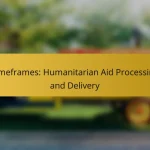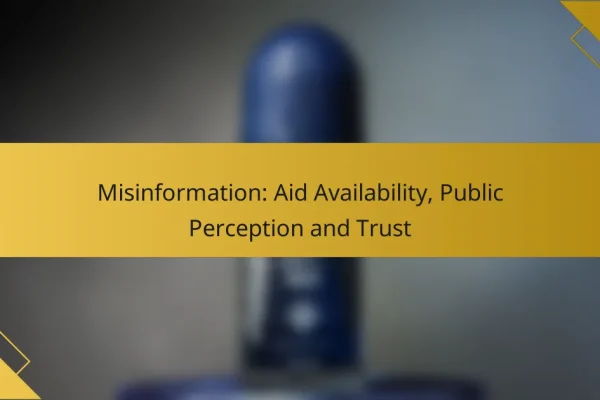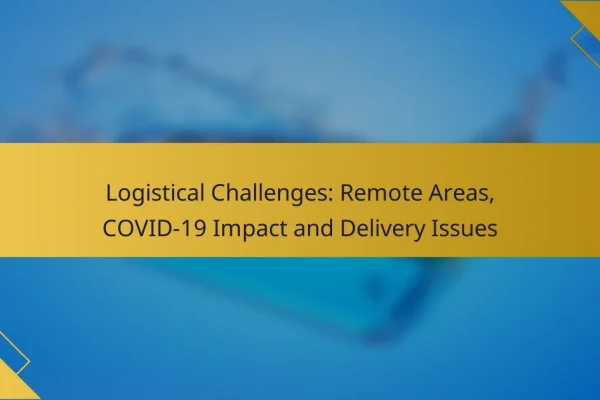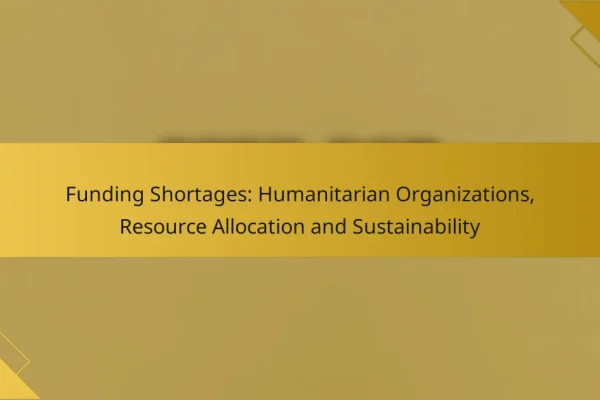What are the main challenges in humanitarian aid?
The main challenges in humanitarian aid include resource allocation issues, logistical barriers, political interference, cultural misunderstandings, and coordination among agencies. Each of these factors can significantly impact the effectiveness and efficiency of aid delivery in crisis situations.
Resource allocation issues
Resource allocation issues arise when there is a mismatch between available aid and the needs of affected populations. Limited funding and resources often lead to difficult decisions about where to direct assistance, which can result in some areas receiving inadequate support.
To mitigate these challenges, organizations should prioritize needs assessments and use data-driven approaches to allocate resources effectively. Regularly reviewing and adjusting allocations based on evolving circumstances can also help ensure that aid reaches those who need it most.
Logistical barriers
Logistical barriers can hinder the delivery of humanitarian aid, particularly in remote or conflict-affected areas. Challenges such as damaged infrastructure, lack of transportation, and security concerns can delay or prevent aid from reaching its intended recipients.
To overcome these barriers, agencies should develop contingency plans that include alternative transportation routes and partnerships with local organizations. Investing in robust supply chain management can also enhance the efficiency of aid distribution.
Political interference
Political interference often complicates humanitarian efforts, as governments may impose restrictions on aid delivery or prioritize certain groups over others. This can lead to unequal access to assistance and exacerbate existing tensions within affected communities.
Humanitarian organizations must navigate these political landscapes carefully, advocating for impartial aid access while maintaining neutrality. Building relationships with local authorities can help facilitate smoother operations and reduce the risk of interference.
Cultural misunderstandings
Cultural misunderstandings can create barriers to effective communication and trust between aid workers and local communities. Misinterpretations of customs, beliefs, or languages can lead to resistance or rejection of aid initiatives.
To address these issues, organizations should invest in cultural competency training for staff and engage local leaders in the planning and implementation of aid programs. Listening to community feedback can also help tailor assistance to meet local needs and expectations.
Coordination among agencies
Coordination among agencies is crucial for maximizing the impact of humanitarian aid. Poor collaboration can lead to duplicated efforts, wasted resources, and gaps in assistance. Effective coordination ensures that all actors are working towards common goals.
Establishing clear communication channels and regular coordination meetings can enhance collaboration. Utilizing shared platforms for information exchange can also help agencies align their efforts and improve overall response effectiveness.
How can technology improve humanitarian aid?
Technology can significantly enhance humanitarian aid by streamlining logistics, improving communication, and enabling data-driven decision-making. By leveraging tools like drones, data analytics, and mobile applications, organizations can respond more effectively to crises and allocate resources more efficiently.
Use of drones for delivery
Drones are increasingly used in humanitarian aid to deliver supplies to hard-to-reach areas quickly and safely. They can transport essential items such as food, medicine, and medical equipment, often bypassing obstacles like damaged infrastructure.
When deploying drones, organizations should consider factors such as flight regulations, local airspace restrictions, and the weight capacity of the drones. For instance, many drones can carry payloads of up to a few kilograms, making them suitable for small but critical deliveries.
Data analytics for needs assessment
Data analytics plays a crucial role in assessing the needs of affected populations during humanitarian crises. By analyzing data from various sources, including surveys and social media, organizations can identify the most pressing needs and prioritize their response accordingly.
Effective data analytics requires robust data collection methods and tools. Organizations should focus on gathering real-time data to make informed decisions, ensuring they can adapt their strategies as situations evolve. Utilizing platforms that aggregate data from multiple sources can enhance the accuracy of assessments.
Mobile apps for communication
Mobile applications facilitate communication between aid organizations and affected communities, ensuring that information flows efficiently. These apps can provide updates on available services, safety information, and ways to access aid.
When developing mobile apps for humanitarian purposes, it is essential to consider user accessibility and language barriers. Apps should be designed to work offline and in low-bandwidth environments, as many affected areas may lack reliable internet access. Additionally, incorporating local languages can improve user engagement and effectiveness.
What are the funding challenges in humanitarian aid?
Funding challenges in humanitarian aid primarily stem from inconsistent donor support, competition for limited resources, and the impact of economic downturns. These factors complicate the ability of organizations to deliver timely and effective assistance to those in need.
Inconsistent donor support
Inconsistent donor support refers to the unpredictable nature of funding from governments, private entities, and international organizations. This variability can lead to gaps in funding, making it difficult for humanitarian agencies to plan and execute long-term projects.
For example, some donors may commit to funding for a specific period but withdraw support unexpectedly, leaving projects underfunded. Humanitarian organizations often have to adapt quickly to these changes, which can disrupt ongoing efforts and affect the communities they serve.
Competition for limited resources
Competition for limited resources is a significant challenge in the humanitarian sector, as multiple organizations vie for the same pool of funding. This competition can lead to a fragmented approach to aid, where efforts are duplicated and resources are not utilized efficiently.
Organizations may need to prioritize certain projects over others based on available funding, which can result in critical needs being overlooked. Collaborating with other agencies and sharing resources can help mitigate this issue, but it requires effective communication and trust among partners.
Impact of economic downturns
The impact of economic downturns on humanitarian aid funding can be severe, as governments and donors may reduce their contributions during financial crises. This reduction in funding can lead to a decrease in the overall capacity to respond to emergencies and support ongoing programs.
For instance, during economic recessions, donor countries may prioritize domestic spending over international aid, resulting in significant shortfalls for humanitarian organizations. To navigate these challenges, agencies may need to diversify their funding sources and explore innovative financing mechanisms to ensure sustainability.
How do local partnerships enhance humanitarian efforts?
Local partnerships significantly enhance humanitarian efforts by fostering collaboration, trust, and cultural understanding. They enable organizations to leverage community resources and insights, leading to more effective and relevant aid delivery.
Building trust within communities
Trust is essential for successful humanitarian operations. When organizations partner with local entities, they demonstrate commitment to the community, which can lead to increased cooperation from residents. This trust can be built through consistent engagement and transparency in operations.
For example, involving community leaders in decision-making processes can help align aid initiatives with local needs, fostering a sense of ownership and responsibility among community members.
Leveraging local knowledge
Local knowledge is invaluable in humanitarian efforts, as it provides insights into cultural practices, social dynamics, and logistical challenges. By working with local partners, organizations can access this knowledge, ensuring that aid is culturally appropriate and effectively targeted.
For instance, local partners can identify the most effective communication channels to reach vulnerable populations, which can vary widely from one community to another. This tailored approach can significantly improve the impact of humanitarian programs.
Improving sustainability of aid
Partnerships with local organizations can enhance the sustainability of humanitarian aid by promoting self-reliance within communities. When local entities are involved, they can help design programs that build local capacity and resilience, reducing dependence on external aid over time.
Additionally, local partnerships can facilitate the transfer of skills and resources, ensuring that communities are better equipped to handle future crises. This approach not only benefits the immediate situation but also lays the groundwork for long-term development and stability.
What role do international organizations play in humanitarian aid?
International organizations are crucial in coordinating and delivering humanitarian aid during crises. They provide essential support through logistics, funding, and expertise, ensuring that aid reaches those in need effectively and efficiently.
Coordination of global responses
International organizations facilitate the coordination of global responses to humanitarian crises by bringing together various stakeholders, including governments, NGOs, and local communities. They establish frameworks for collaboration, ensuring that efforts are not duplicated and resources are utilized optimally.
For example, during natural disasters, organizations like the United Nations Office for the Coordination of Humanitarian Affairs (OCHA) lead coordination meetings to align the actions of different agencies. This helps streamline operations and improve the overall effectiveness of the response.
Funding and resource mobilization
International organizations play a pivotal role in mobilizing funding and resources for humanitarian aid. They often serve as intermediaries, channeling donations from governments and private entities to the areas most in need. This funding is critical for purchasing supplies, providing medical care, and supporting displaced populations.
Typically, these organizations launch appeals for funding, detailing specific needs and projected costs. For instance, a humanitarian appeal might request millions of USD to address food insecurity in a conflict zone. Effective communication about the urgency and impact of these needs can significantly influence donor contributions.












